moritz wagner

I wish I had anything other than grimace emojis to show you. Michigan announces limited seating at Michigan Stadium this fall "if U-M is able to have a 2020 football season":
- There will be no football season tickets. Status as a season ticket holder remains unchanged, and season ticket locations will be retained for the 2021 season.
- If U-M is able to have fans at Michigan Stadium, all home games will be sold on an individual game basis, with sales limited to current season ticket holders and students. There will be no ticket sales to the general public.
- For season ticket holders who elected to adjust their season ticket location/quantity during the June upgrade period, that new location/quantity will be retained for the 2021 season.
- Details regarding a potential individual game sale will be communicated once a decision on playing with or without fans is finalized.
- In the event that Michigan is able to have fans at any sporting event this season, all forms of ticketing will move to a mobile platform.
We've heard on background that we're looking at maybe 20k people, most of them students. Obviously this is a developing situation, as they say. If I was a betting man I'd guess the number of fans would be zero.
[After the JUMP: sucking yet more air through teeth]
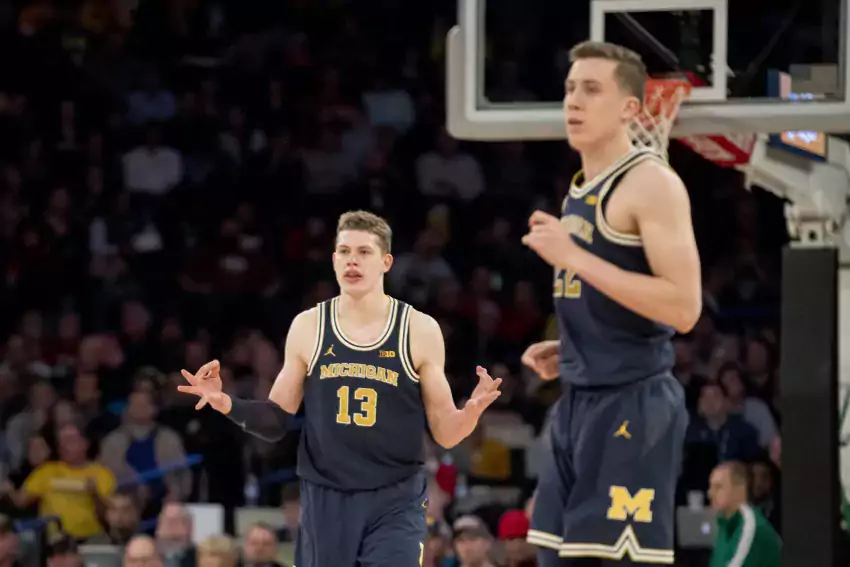
MGoTheater 3000 Note: Michigan vs. Kansas, 2013 Sweet Sixteen, tonight, 8 pm ET, here on the front page and at twitch.tv/mgoace.
Today's basketball mailbag, as the title indicates, contains some indispensable information. I got enough questions to break this into two parts, so if you don't see yours here, there's a good chance it's running later this week.
Which team wins:
— Koernelius (@DJKoerndawg) March 24, 2020
Five Nik Stauskas's vs Five Mo Wagners
I hoped by sleeping on this question it'd be easier to answer. I was very wrong!
I assume we're going with the best version of each player while they were at Michigan. Wagner obviously has the edge in size while Stauskas gains an advantage in athleticism. Both can really shoot; Stauskas is the better outside marksman while Wagner has an array of post moves. The team of Stauskases (Stauskae?) will move the ball better and base an offense around isolations and a lethal pick-and-pop. The Wagners offense won't be as pretty, though it'll still feature some pick-and-pop.
It comes down to this: will the greater offensive skill and ball movement of the Stauskae overcome a rebounding advantage for the Wagners? In the end, I think the Niks are a half-step too quick.
Five Duncan Robinsons?
— Jonathan Moore (@jadamsmoore) March 24, 2020
Today's Duncan Robinson would make this really difficult—or perhaps not, he may just take it—as he's developed into one of the NBA's most dangerous shooters in Miami. While he was undoubtedly a great shooter at Michigan, he didn't possess the ability to hit shots on the move that he does now—he was a pure spot-up guy.
Since I'm, uh, sensing a theme, let's lean all the way into it. Top Ten White Guy Fives rankings since the start of the Beilein era:
- Nik Stauskas
- Mitch McGary
- Moe Wagner
- Iggy Brazdeikis
- Zack Novak
- Franz Wagner
- Duncan Robinson
- Stu Douglass
- Jon Teske
- Spike Albrecht
Being particularly large or small is a disadvantage here, with apologies to Teske and Spike. Mitch McGary may not have the outside shot of his counterparts, but his combination of offensive skill, defensive disruptiveness, and ability to bring a high level of energy put him above Wagner for me. If he played a little more in control, I'd have him above Stauskas, but the latter made too few mistakes.
Franz Wagner has the potential to move up very high on this list, which is an essential one indeed.
[Hit THE JUMP for more silliness, then some actual basketball analysis, then maybe a little more silliness.]
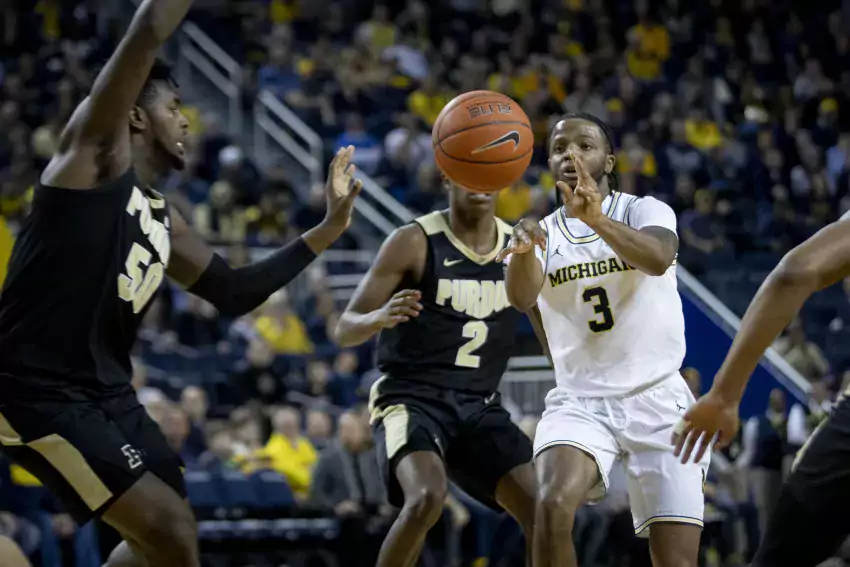
Previously: Part One, Part Two. If you're looking for the Rutgers preview it's here.
You're definitely going to want to at least read part two of this series, which explains the stats I'm using below and details the 2009-14 seasons, before moving on to the rest of this post. Ideally, you'll read part one, as well.
Now that you're caught up, let's get to it.
2014-15: Bad Wheels
Team Stats: 27.7% pick-and-rolls + passes (#36 in country), 0.911 points per play (#62)
The Ballhandlers:
| P&R Plays (Own Offense) | PPP on Own Offense (%ile) | P&R Plays (Passes) | PPP on Passes (%ile) | Total P&R Plays | Overall P&R PPP. (%ile) | Keep % | |
|---|---|---|---|---|---|---|---|
| Spike Albrecht | 65 | 0.815 (70%) | 98 | 1.276 (92%) | 178 | 1.092 (93%) | 36.5% |
| Caris LeVert | 87 | 0.644 (35%) | 58 | 0.862 (34%) | 145 | 0.731 (28%) | 60.0% |
| Derrick Walton | 52 | 0.635 (33%) | 61 | 0.967 (54%) | 113 | 0.814 (47%) | 46.0% |
| Zak Irvin | 60 | 0.783 (63%) | 43 | 1.395 (96%) | 103 | 1.039 (90%) | 58.3% |
| MAAR | 39 | 0.872 (79%) | 19 | 1.737 (100%) | 58 | 1.155 (96%) | 67.2% |
The Screeners:
| Pop Plays (%) | Pop PPP (%ile) | Roll Plays | Roll PPP (%ile) | Slip Plays (%) | Slip PPP (%ile) | Overall Plays | Overall PPP (%ile) | |
|---|---|---|---|---|---|---|---|---|
| Max Bielfeldt | 12 (36.4%) | 1.167 (88%) | 19 (57.6%) | 1.000 (30%) | 2 (6.1%) | 2.000 (—) | 33 | 1.121 (76%) |
| Ricky Doyle | 1 (3.6%) | 2.000 (—) | 26 (92.9%) | 1.308 (74%) | 1 (3.6%) | 0.000 (—) | 28 | 1.286 (90%) |
| Zak Irvin | 9 (69.2%) | 1.222 (—) | — | — | 4 (30.8%) | 2.000 (—) | 13 | 1.462 (96%) |
| Mark Donnal | 1 (10%) | 3.000 (—) | 9 (90%) | 1.556 (—) | — | — | 10 | 1.700 (99%) |
I almost didn't include this season or the next because of Michigan's injury issues, then decided it was useful to see what happens when a team's two best perimeter players get hurt in the same season.
While neither Caris LeVert nor Derrick Walton were producing particularly well in the pick-and-roll before their respective foot injuries, we saw later that these injuries delayed breakouts into effective players—Walton, in particular, eventually became a great P&R ballhandler.
The players that remained were effective but one-dimensional. Spike Albrecht drove to pass. Zak Irvin and Muhammad-Ali Abdur-Rahkman hunted shots off of screens. Irvin, defying reputation, struck the best balance between shooting and passing, and he was a very effective passer. Only MAAR was above-average at generating his own offense off of screens, though.
Derrick Walton's foot injury stunted a developing rapport with Ricky Doyle
Michigan was also working with a limited group of finishers. Ricky Doyle was the best roll man but was a roll man only. Max Bielfedlt(!) ended up with the most plays among screeners even though he was a 30th-percentile finisher on the roll; he salvaged decent efficiency with some pick-and-pop jumpers. If Zak Irvin was setting a screen, it was to pop or slip for a jump shot.
This marks the first season since 2008-09 that Michigan's pick-and-roll usage went down; they also slipped 40 spots in the efficiency rankings. This team was going to drop off with the departures of Nik Stauskas, Glenn Robinson III, and Jordan Morgan, then injuries made matters worse. Even if LeVert and Walton weren't high-level P&R ballhandlers at this point, their spot-up shooting could've helped.
Even with all that, Michigan's pick-and-roll offense ranked in the 83rd percentile by points per play. They weren't elite; they were still good. They just couldn't build the offense around it to the extent they had the previous year.
2015-16: Bad Wheels 2
Team Stats: 30.5% pick-and-rolls + passes (#22 in country), 0.923 points per play (#80)
The Ballhandlers:
| P&R Plays (Own Offense) | PPP on Own Offense (%ile) | P&R Plays (Passes) | PPP on Passes (%ile) | Total P&R Plays | Overall P&R PPP. (%ile) | Keep % | |
|---|---|---|---|---|---|---|---|
| Derrick Walton | 128 | 0.711 (44%) | 120 | 1.000 (59%) | 248 | 0.851 (51%) | 51.6% |
| Zak Irvin | 149 | 0.826 (68%) | 98 | 1.306 (93%) | 247 | 1.016 (86%) | 60.3% |
| Caris LeVert | 57 | 0.877 (77%) | 62 | 0.855 (32%) | 119 | 0.866 (54%) | 47.9% |
| MAAR | 67 | 0.910 (82%) | 41 | 0.805 (24%) | 108 | 0.870 (55%) | 62.0% |
| Duncan Robinson | 19 | 0.632 (29%) | 17 | 0.647 (9%) | 36 | 0.639 (14%) | 52.8% |
The Screeners:
| Pop Plays (%) | Pop PPP (%ile) | Roll Plays | Roll PPP (%ile) | Slip Plays (%) | Slip PPP (%ile) | Overall Plays | Overall PPP (%ile) | |
|---|---|---|---|---|---|---|---|---|
| Mark Donnal | 12 (21.8%) | 0.500 (12%) | 40 (72.7%) | 1.250 (60%) | 3 (5.5%) | 0.667 (—) | 55 | 1.055 (60%) |
| Ricky Doyle | 1 (2.9%) | 2.000 (—) | 30 (88.2%) | 1.200 (54%) | 3 (8.8%) | 0.333 (—) | 34 | 1.147 (73%) |
| Moe Wagner | 3 (15.8%) | 1.667 (—) | 16 (84.2%) | 1.375 (77%) | — | — | 19 | 1.421 (95%) |
| DJ Wilson | 9 (64.3%) | 0.556 (—) | 4 (28.6%) | 1.500 (—) | 1 (7.1%) | 0.000 (—) | 14 | 0.786 (24%) |
| Zak Irvin | 9 (81.8%) | 1.000 (—) | — | — | 2 (18.2%) | 0.000 (—) | 11 | 0.818 (27%) |
An unfortunate repeat, as Walton's previous foot injury sapped his ability to finish at the rim and LeVert—who'd improved considerably as a scorer off the high screen—again lost most of the season to a bad wheel.
Beilein increased the volume past where it had been in 2013-14 and the team's PPP slightly increased, though they came out worse compared to the rest of the country. Irvin was easily the team's best P&R ballhandler, continuing to pass at a high level while making enough pull-up jumpers to be relatively effective as a scorer.
some of those jumpers were rather important
MAAR pulled off a tough feat, averaging more PPP using his own offense than when he passed; that's very much a good news/bad news situation.
The roll men remained limited. This was the year Ricky Doyle seemingly lost the ability to catch and finish, so Mark Donnal ended up as the primary screener. Neither graded out particularly well. The center who did: enigmatic freshman Moe Wagner, who scored well as a roll man and flashed the ability to pop out and hit jumpers.
[Hit THE JUMP for Michigan exploring that a bit more.]

Oh, just Duncan Robinson and Moe Wagner protecting NBA rims, nothing to be concerned about.
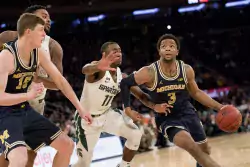
As a sophomore, Zavier Simpson quietly showed flashes of the level of pick-and-roll mastery Michigan will need from him in 2018-19.
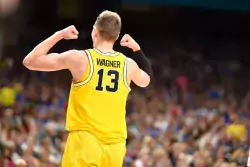
ESPN lives! For basketball at least! Moe Wagner has a bad day! Poole is on NBA draft radars! Please, Vancouver, give me one more year of Quinn Hughes, I beg you!

Purdue is mad! Other people are chastized for madness! Basketball scheduling makes sense! The porpoises are our enemy! Jack Hughes is not happening, your author is going to go weep in a closet!

We roundtable our favorite Moe Wagner moments
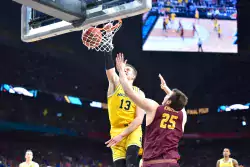
olajuwon. bird. wagner. close as three friendly seals.

121